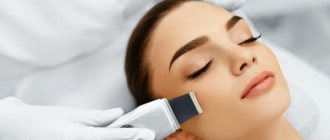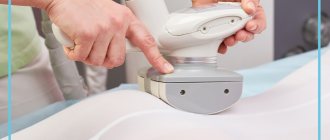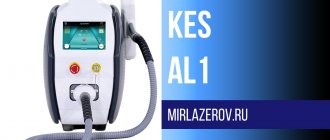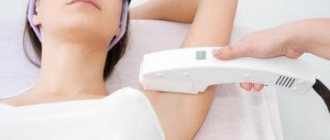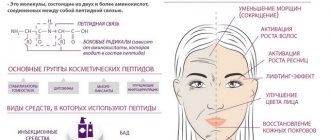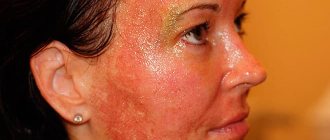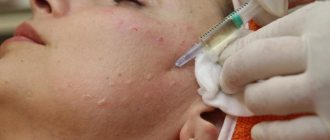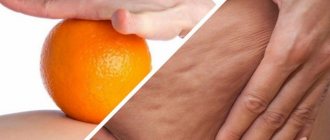From this article you will learn:
- What is diode laser hair removal
- What effect does the procedure help achieve?
- What are the pros and cons of diode laser hair removal?
- Who is the procedure contraindicated for?
- How to prepare for diode laser hair removal
- How does the procedure work?
- How to care for your skin after laser hair removal
Diode laser hair removal is a method of removing unnecessary body hair, which currently provides almost the most effective and long-lasting effect. Regular shaving helps only for a short time, since only the visible part of the hair is removed, and the follicle remains unharmed, so growing specimens have to be removed almost daily.
Laser device
A diode laser is used for hair removal. However, unlike photoepilation, this method is guided by a different operating principle: a narrow beam of light with a constant wavelength (808-810 nm) is directed to the desired area of the skin. This wavelength is perfectly absorbed by melanin.
The beam comes from the emitter and passes through optical materials (sapphire or quartz glass) to the skin. Sapphire glass has the best light transmittance, thermal conductivity and hardness. Quartz glasses have impurities that retain and therefore absorb light energy.
To reduce pain, the laser tip is equipped with a special cooling system. The method is contact, that is, cooling occurs by touching the skin due to the operation of Peltier elements (they are located in the diode handle). There is also a water cooling system - it works through radiators together with fans.
The whole point of cooling is to remove heat from hot parts of the equipment. To take heat from one part of the device to another, a “coolant” is used - distilled water. Being under pressure, it passes through the channels, taking heat with it, discharging it towards the radiator or fan.
Indications for use
Most often, people remove body hair for aesthetic reasons. In addition, this not only affects the smell (more precisely, the absence of an unpleasant odor of sweat), but also greatly facilitates personal hygiene.
When is diode laser hair removal indicated?
· with active hair growth
· in the presence of “undesirable vegetation” in hard-to-reach areas
· if irritation or significant rashes develop while using a regular razor (most often this happens in the case of overly sensitive skin)
Regular appearance of ingrown hairs or in the presence of too tough “vegetation” that cannot be removed by other means
Working principle of a diode laser
The operating principle of diode hair removal is simple: it consists in the fact that a laser beam acts on melanin, which gives color to the hair. Laser radiation is absorbed by melanin, the hair heats up, transferring the temperature through the shaft to the hair follicle, which is destroyed under the influence of high temperature.
The diode laser is effective for hair of all colors, except colorless ones. But it still produces the best effect on dark hairs, since they contain a large amount of melanin, which absorbs laser radiation. The procedure requires systematic implementation, since only then the number of hairs will decrease for a long time from a year to 1.5 years.
The laser only affects hair that is in the active growth stage; the radiation will not affect “dormant” hair follicles. That is why it is important to complete a full course of hair removal, observing the intervals prescribed by the doctor.
Diode laser hair removal: preparation and process
- Preparation
- You should not use other hair removal methods in areas where laser diode hair removal is planned.
- The day before the procedure, it is recommended to shave off the vegetation in the growth area. The length of the remaining hairs should not exceed 1 mm. If there are long specimens, the diode laser beam will take longer to reach the follicles and will work less efficiently, resulting in additional sessions.
- The procedure time ranges from 10 to 60 minutes and depends on the area of the epilated area. Removing hair from multiple areas at once can take up to four hours.
- Technique
The client sits on a cosmetology couch. The specialist performing the procedure must wear protective glasses on both the visitor and himself to protect his eyes from radiation. The epilation area is then treated with short bursts of a diode laser. With each outbreak, the hairs in the follicles are destroyed by high temperature, so a burnt odor may be present.
After completing the procedure, a cosmetic product is applied to soften the skin and prevent burns. Recommendations from a specialist in caring for the treated area are mandatory.
- Post-procedure care
After laser hair removal, you should avoid exposure to ultraviolet radiation for about two weeks so as not to provoke unpleasant consequences. When going outside, it is necessary to apply sunscreen to exposed skin.
For complete success in the fight against unnecessary body hair, you need to repeat the procedure three to four more times. The break between sessions is about one to two months. If there is a lot of hair and its intensive growth continues, then the next procedure is carried out after four weeks, with moderate growth - after two months.
Nowadays, you no longer have to spend a lot of time performing complex and unpleasant procedures at home. It is much easier to seek help from real professionals - the Veronika Herba beauty and health center, equipped with effective and modern equipment.
Why clients choose Veronika Herba Beauty and Health Center:
- This is a beauty center where you can take care of yourself at a reasonable cost, while your face and/or body will be treated not by an ordinary cosmetologist, but by one of the best dermatologists in Moscow. This is a completely different, higher level of service!
- You can receive qualified help at any time convenient for you. The beauty center is open from 9:00 to 21:00, seven days a week. The main thing is to agree with your doctor in advance on the date and time of your appointment.
Sign up for a consultation with a specialist by phone +7 (495) 085-15-13
, and you will see for yourself!
Advantages of the device
The pros and cons of diode lasers for hair removal will help you understand whether the procedure is worth carrying out or not. But this method of getting rid of unwanted hair definitely has more advantages than disadvantages.
The main advantages are contact cooling of the skin during the procedure, regulation of the power of the device and the ability to work in dynamic or stamp mode, which is why the equipment is effective on various skin types.
An undeniable advantage is the safety of the procedure, since the laser does not damage the skin, which means there will be no irritation or burns after the session. Since the method involves selective exposure. Only the hair structures are heated and destroyed; the surrounding tissues are not injured.
Other advantages of the procedure:
- Short recovery period (1-2 days);
- Performing laser hair removal on dark skin;
- No side effects if the procedure is carried out correctly;
- Cooling the skin during the procedure.
But the method also has disadvantages. So, if the patient has blond hair, he will need more procedures. Also, diode hair removal is quite expensive and is characterized by some pain (especially in the face and bikini area). On the other hand, absolutely all laser hair removal is associated with unpleasant and painful sensations.
Disadvantages of diode laser hair removal
Side effects that may occur during hair removal include:
- Redness of the skin at the treatment site appears on the sensitive dermis and disappears after the end of the session and does not require special treatment. If there is significant discomfort, you can treat the area with a burn remedy containing panthenol.
- Unpleasant sensations if the client has a low pain threshold or the hair being removed has a large amount of melanin pigment and a hard structure. In this case, local anesthesia with modern drugs is usually offered.
- The high cost of innovative equipment does not make it possible to make diode laser hair removal procedures cheaper. The price for the complex is significant, since one session is not enough to achieve a lasting effect of smooth skin.
- Dormant follicles, which will resume hair growth in the future, are not destroyed during the current procedure, so hair removal in the selected area is repeated several times.
Read material on the topic: Laser hair removal of armpits: answers to the 8 most popular questions about the procedure
Effectiveness of the procedure
Diode laser for hair removal is considered a more popular and effective method of hair removal, since its rays are best absorbed by melanin, while they do not injure adjacent tissues, blood vessels and the skin itself. By acting on the hair follicle, the laser completely destroys it, causing the hair to fall out and no longer grow in this area.
After about 6-12 procedures, the procedure will have the desired effect, and all hair will completely disappear. However, to maintain smooth skin, it is necessary to undergo maintenance laser hair removal procedures.
Diode laser hair removal: smooth skin effect after 5-6 sessions
Complete destruction of the follicular part of the hair, which is responsible for its growth, requires four to five times exposure to a diode laser. For thin and sparse vegetation, two sessions are sufficient. With a more rigid structure, up to seven procedures may be required for final hair removal.
As a rule, four to five sessions are enough for women, while men will have to visit the salon more times. With each procedure, the effect will become stronger: areas of skin free from vegetation will increase, and the remaining hair will thin, lose color and fall out.
Six procedures may take six months, but after this period you can forget about shaving and enjoy smooth skin.
Read material on the topic: Laser hair removal of the abdomen: contraindications, features of the procedure and care
Who is contraindicated for diode hair removal?
Diode hair removal has its own contraindications, which should be taken into account before making an appointment with a cosmetologist:
- During pregnancy and breastfeeding;
- Tan acquired less than 2 weeks ago;
- Violation of the integrity of the skin in the work area;
- Use before the procedure of any type of hair removal and depilation, except for a machine or trimmer;
- History of epilepsy;
- Presence of oncology;
- A large number of moles or warts in the projection of the work;
- Dermatological diseases;
- Phlebeurysm;
- Hormonal imbalances.
Practical guide
Patient selection
Hair color and skin type allow us to determine how effective laser hair removal procedures will be for a particular patient. Patients with red, gray or blond hair should not expect long-term hair loss. Having a tan is also important. Patients with tanning should avoid sun exposure and use whitening cream and sunscreen.
Since the laser target is the chromophore in the hair shaft, it is important that it is in the follicle during the procedure. Therefore, patients should not use sugaring, waxing or electrolysis for at least 6 weeks before the procedure. You can use a razor and depilatory creams as they leave the hair shaft in the follicle.
It is important to study the patient’s medical history and the state of the endocrine system. Patients with hirsutism can be treated regardless of the cause. Patients who have had herpes type 1 or 2 should start using antiviral drugs the day before the procedure. This is especially important for the upper lip area or bikini line, since reactivation of herpes simplex type 1 or 2 is possible after laser treatment.
Carrying out the procedure
Before the procedure, it is necessary to shave the treated area, otherwise the outer part of the hair shaft will burn, causing a burning sensation on the skin. It is possible to use depilatory cream for patients who object to shaving.
No anesthesia is usually required, however it depends on the area and area being treated. For the upper lip, it is recommended to use an anesthetic cream.
There is a high risk of eye damage with the laser, since the retina of the eye has a very high concentration of melanin. For this reason, the procedure should not be performed near the eyes; it is important that everyone present in the room (patient, doctor, nurse) wear protective glasses. During the procedure, it is necessary to regularly clean the tip; when the hair shaft becomes charred, it leaves marks on the sapphire crystal, which can make it hot and impede the penetration of radiation. The tip can be cleaned with alcohol. There is a small but real risk of infection as the handpiece is in direct contact with the skin, so between treatments the handpiece should be disinfected using a liquid disinfectant.
Selecting fluence
The color of hair and skin, as well as the frequency of flashes and the size of the working area determine the most appropriate fluence value. For dark skin types IV to VI, it is better to use values twice as low as for light skin types.
The procedure should be performed with the highest energy density value that is comfortably tolerated by the patient. Research shows that the effectiveness of hair loss depends on the fluence used.
Each skin type has its own threshold of energy density at which pigmentation changes occur. To minimize hypo- or hyperpigmentation, set fluence values lower than recommended, based on your clinical experience.
By using multiple high-energy pulses on the same area, the likelihood of pigment changes increases without increasing effectiveness. For this reason, double or triple pulses on the same area in the classical technique (one pass with maximum fluence) are not recommended.
Make a test single pulse within or near the treatment area. If there are signs of epidermal damage (bloating, ablation, lightening of the epidermis), the energy density should be reduced by 5-10 J/cm2. Then apply several pulses next to each other to produce an epidermal response. Effective energy density is achieved by hair carbonization, selective follicular swelling and redness (Figure 4).
Marking the skin into different zones can be very helpful. A polarized light source with a magnifying glass allows you to visualize individual follicles, helping to determine the effectiveness of the chosen procedure.
Loss of hair carbonized by the laser from the follicle may occur within a few days, patients may think it is hair growth, however, these hairs can be easily removed with tweezers.
Figure 4 – Immediately after the procedure, bikini area, skin type II, 40 J/cm2, 20 ms.
There is a cumulative effect for the second procedure. The second procedure should be carried out after the hair has been grown; this period will be different for different areas. For the face, armpits, bikini area, this is usually from one to two months. For the back and legs, this period will be from two to three months.
Perifollicular swelling and redness of the skin indicate that the area has been treated with sufficient fluence. Swelling and burning sensation can usually last from 1 to 3 hours after the procedure. For relief, you can use cooling compresses. The redness may last for several days but is easily covered with makeup. After the procedure, patients should avoid exposure to sunlight.
How long does it take for hair to fall out?
After the first session, you should not expect an immediately noticeable result, since during the first exposure to the ray, hair that is in the growth stage is removed, and this constitutes only 30% of all existing hair. After several sessions, follicles that were previously in the 2nd and 3rd growth phases are destroyed.
On average, 6-12 procedures are required for complete hair loss. However, the effectiveness of removal depends on many factors: hormonal levels, hair color, location, quality of work, the experience of the specialist, what device the procedure was used on.
Efficiency
Ninety-two patients (45 men and 47 women) with various skin types (I to VI, predominantly II and III) participated in the first large clinical trial of diode laser hair removal[3]. The study evaluated various combinations of energy density and pulse duration (Table 1), using a 9x9 cm2 tip with vacuum exposure. Hair condition was assessed 1, 3, 6, 9 and 12 months after the last treatment using digital photographs with magnification. Special marks were used to determine the processing area.
Table 1 – Study results for various parameters.
| Options | Procedures | Reduction in hair amount at different times after the procedure, % | ||||
| 1 month | 3 months | 6 months | 9 months | 12 months | ||
| 5 ms, 15 J/cm2 | 1 | 65,4 | 21,5 | 17,9 | 15,5 | 26,6 |
| 10 ms, 20 J/cm2 | 1 | 66,7 | 21,0 | 22,2 | 20,7 | 25,9 |
| 15 ms, 30 J/cm2 | 1 | 70,8 | 30,2 | 28,7 | 30,6 | 29,4 |
| 20 ms, 40 J/cm2 | 1 | 70,2 | 26,8 | 29,8 | 32,5 | 32,5 |
| 20 ms, 40 J/cm2 | 2 | 69,3 | 51,5 | 37,1 | 42,3 | 46,6 |
| 20 ms, 40 J/cm2 x3 | 2 | 71,1 | 51,9 | 36,8 | 41,4 | 46,2 |
| 20 ms, 40 J/cm2 x3 | 1 | 68,9 | 30,8 | 32,3 | 32,4 | 38,5 |
| Control group | 0 | 17,3 | 10,5 | 10,8 | 6,3 | 5,5 |
After diode laser procedures, 100% of patients experienced temporary hair loss, 89% of patients experienced long-term (permanent) hair reduction during a year of observation after the last procedure.
When using parameters of 20 ms, 40 J/cm2 and two procedures, the number of hairs decreased by an average of 46.6%, the second procedure significantly increased efficiency. A triple pulse for the same area (1 pulse per second) did not increase the effectiveness of the procedure, and the number of side effects increased.
Of the 11% of patients who did not experience long-term hair loss, the majority had blond hair. Since blond hair contains less melanin than dark hair, and therefore less chromophore required for heating from laser radiation. However, these patients experienced temporary hair loss.
The new growths became lighter and thinner than before the procedure. Hair color was measured by calculating the absorption coefficient of light reflected from hair with a wavelength of 700 nm. Diameter was measured from digital photographs. The study showed that the new hair was lighter (the reflectance coefficient was 1.41 times higher than before the course of procedures) and thinner (the average diameter decreased by 19.9%).
Histological studies have shown two mechanisms of hair reduction: reduction of large hair follicles to the size of vellus hair follicles, destruction of the hair follicle with granulomatous degeneration and the formation of a fibrous residue. Clinically, both of these mechanisms lead to long-term hair reduction. The sebaceous glands located next to the treated follicles received either minimal or no damage; sweat glands and capillaries were in normal condition on histological examination.
The study used a fixed set of fluence and pulse length combinations for each patient, regardless of their skin type, to investigate possible negative effects. If skin type and skin color were matched to the appropriate combination of parameters, the number of side effects was reduced. Epidermal damage was noted in 6% of cases, changes in skin texture in 3% of cases, when using triple pulse and the highest fluence. All observed side effects disappeared after 3 months. Transient pigmentation was noted in approximately 10% of cases and tended to occur in patients with darker skin or those who did not use photoprotection during procedures.
Research shows that high power diode laser causes two effects: temporary hair loss and long-term hair reduction. Temporary hair loss occurs in all patients, for all hair colors and with any fluence, lasting from 1 to 3 months.
Long-term hair reduction is defined as a significant reduction in the amount of hair growing on specific parts of the body for a period longer than a full follicle growth cycle for that area (Figure 3, Table 2).
Figure 3 – Phases of hair growth. Anagen is the active growth phase, catagen is the regression phase, and telogen is the resting phase.
Table 2 - Hair growth cycles for various anatomical zones.
| Location | Telogen (months) | Anagen (months) | Total (months) |
| Back | 3-6 | 3-6 | 6-12 |
| Hip | 3-6 | 3-6 | 6-12 |
| Hand | 3-5 | 1-2 | 4-7 |
| Caviar | 3-4 | 4-5 | 7-9 |
| Armpits | 2-3 | 3-4 | 5-7 |
| Above the upper lip | 1-2 | 3-4 | 4-6 |
| Bikini | 3-4 | 2-3 | 5-7 |
There is a difference between permanent hair removal and complete hair loss. Complete hair loss means that hair growth stops. The cessation of growth may be temporary or permanent. Diode laser usually results in complete but temporary hair loss followed by partial but long-term hair reduction. This is an important point to explain to the client when setting expectations for the procedure.
What restrictions might there be?
The effect of a diode laser epilator on the body is a very complex process. There are several reasons for refusing the procedure. Among the main contraindications are:
- Pregnancy and lactation period.
- Skin diseases and damage to the epidermis.
- Viral diseases in the area of intended treatment.
- Insulin dependence (diabetes mellitus).
- Oncological diseases that may develop.
- Severe form of cardiac hypertension.
- Epilepsy.
- Lots of moles.
But it is worth noting that some of the contraindications given above are not absolute. Epilation is possible after consultation with a doctor.
Skin anesthesia during diode depilation
It is possible to administer pain relief during the procedure; cosmetologists use anesthetic drugs for this purpose. Prominent pain-relieving ointments and sprays, which are local anesthetics. The client will immediately notice how sensitive laser hair removal is without and with anesthesia. At the request of the patient, an injection is given, but in practice it is not often used.
Top most popular painkillers:
- Lidocaine is sprayed onto the upcoming treatment area several hours before hair removal. After that, cling film is applied to the skin and clothes are put on top. Individual intolerance to the components of this drug is a contraindication for use.
- Emla - is made in the form of a cream containing prilocaine and lidocaine. Emla cream is often used in beauty salons. Excellent pain relief for all areas, including the most delicate and sensitive ones (bikini and armpits). Before use, it is recommended to test for an allergic reaction and first apply the cream mixture to your wrist or elbow. After a while, if no redness appears on the skin, then it can be used in the designated place.
- Depilflax is an anesthetic gel containing natural ingredients menthol, chamomile extract, and tea tree essential oil. Suitable for home use. 15 minutes before depilation, apply the required amount of gel with massaging movements to the area; after complete absorption, you can begin laser depilation.
- Anestop is a gel for local anesthesia. The analgesic effect is intense, fast and long-lasting. Use on clean skin, without open wounds or abrasions. The application method is divided into three stages, the coating interval is 10 minutes. On the last application, keep the composition on the skin for 5 minutes and then wash off with warm water.
- Light Dep is a hypoallergenic cream. The effect begins to take effect after 60 minutes and anesthesia lasts up to 3 hours. It contains castor oil, which moisturizes the epidermis well. Freezing gel is available in different formats: 400ml, 300ml, 150ml, 30ml, etc., with a dispenser and in tubes.
What areas can be epilated using a diode device?
The cold type laser treatment technique is carried out taking into account the skin structure, hair length, health status and medication schedule of the patient. In the absence of contraindications, the technique is performed in the following areas:
- on the face, the cheek area, eyebrows, and skin above the upper lip are treated;
- body core (armpits, décolleté, back and chest);
- buttocks and bikini area;
- hands (elbows, fingers, etc.);
- on the legs, thighs, shins, ankles, and toes are treated.
Tips during the rehabilitation period
Reddened areas do not need to be cooled or overheated to reduce the severity of redness; skin color evens out after 24 hours in the absence of allergies to the components of care products. If you experience symptoms of itching, peeling, burning, or darkening of skin areas, you should consult a doctor. For redness, you can use a hypoallergenic baby cream without fragrances or dyes.
It is recommended to use the following cosmetic products to restore the skin:
- lotions, milk to reduce the intensity of hair growth;
- lotion or cream to soften and moisturize the dermis;
- for burning, itching, microtraumas, you can use antiseptic ointments;
- for irritation, lotions and compresses from decoctions of medicinal herbs (chamomile, yarrow, celandine, calendula, oregano, nettle, linden blossom, string) are used;
- moisturizing mousses and caring oils that help regenerate the skin.
Consequences and side effects
The laser hair removal procedure is safe because... The beam acts on the hair follicle. However, with certain characteristics of the body and insufficient qualifications of the master, the following consequences may occur:
- burns and allergic rashes on delicate skin;
- formation of excess pigmentation;
- exacerbation of herpes;
- photophobia;
- folliculitis;
- furunculosis;
- conjunctivitis;
- redness and inflammation of the skin;
- prolonged swelling;
- itching, peeling, burning.
Slight redness and swelling of the skin 2-4 hours after the session is normal; they do not require treatment procedures other than applying gel, cream and following the skin care recommendations of a cosmetologist. For large areas of redness, you can use a cream that has regenerative and anti-inflammatory properties to treat the dermis.
Contraindications
The use of a diode laser is contraindicated in the following cases:
- moles and papillomas in the area that is treated with ultraviolet light;
- epilepsy;
- fungal skin infections;
- pregnancy;
- breastfeeding period;
- hives;
- presence of damaged skin areas, wounds, scratches;
- keloid scars;
- taking a course of antibiotics;
- severe allergic symptoms.
For hormonal disorders, the procedures are ineffective, because Hair growth does not decrease after laser exposure.
© Nectarine Center, 01/06/2020
Customer Reviews
The majority of clients after diode hair removal are satisfied with the results obtained. With rare exceptions, you can hear reviews about the insufficient effectiveness of the method. But this opinion can be classified as intolerant. In one session it is impossible to remove absolutely all hairs that reduce the quality of life. But if you repeat hair removal twice or three times, the result will be clearly noticeable.
Clients leave positive reviews about laser hair removal with a diode laser on the websites of the beauty salons where the procedure was carried out, so the quality of diode hair removal is assessed in conjunction with the qualifications of the cosmetologist, the quality of the diode laser device and other parameters.
In beauty salons you can find devices of the following brands:
- Light Sheer Desire;
- Me Dio Star Effect;
- Coherent Light Sheer;
- Lightshire et al.
average cost
The cost of hair removal with a diode laser depends on the area of impact, as well as the duration of the procedure. Thus, hair removal of the face or some areas will cost 900 - 4,000 rubles , treatment of the legs will require an investment of 11 thousand rubles , and the cost of hair removal from the bikini is from 2,000 to 6,000 rubles .
Moreover, the price may vary depending on the pricing policy of the salon or its location. In order not to miscalculate the price, you can call or visit several salons. In addition, sometimes there are promotions, discounts and other advantageous offers.
Skin care after the procedure
If you follow the skin care tips after laser exposure, recovery occurs in a short time. The following recommendations should be followed:
- The epilation area is not treated with water for 24 hours;
- Overload in the gym and overheating in the sun are prohibited for 7 days;
- It is required to limit visits to pools and saunas to 3-4 days;
- It is not recommended to perform scrubbing and intense massages on the treated area for 7 days;
- It is optimal to use clothing that does not restrict movement and does not rub the treated areas of the skin;
- It is forbidden to pull out hair on your own: hair follicles fall out on their own after treatment;
- In some cases, it is recommended to treat the skin with panthenol creams for 3-5 days or leave the dermis without treatment for the specified period;
- It is recommended not to use greasy creams and products with a thick consistency during the recovery period to prevent clogging of pores, the appearance of pimples, and blackheads;
- When exposed to the sun, it is necessary to use a cream with sun protection characteristics (35 SPF);
- It is not recommended to use care products with glycolic acid and retinol;
- Treated areas must not be treated with compounds containing alcohol.
How is it different from an alexandrite laser?
The main difference between these two lasers is that the diode laser beam for hair removal has a wavelength of 900 nm, and the alexandrite laser has a wavelength of 725 nm. Diode hair removal allows you to make coarse hairs thinner, reduce the rate of hair growth in a short period of time, and ideally fights fluffy and light hair, but the diode is not good at working with gray hairs. The Alexandrite ray is capable of removing exclusively blond and red hair, and it can also be used to remove tattoos from the body. A diode-based light laser can be used on dark and tanned areas of the skin, which cannot be said about alexandrite. Pain may occur when exposed to an alexandrite-based laser in the form of burning and tingling.
Cosmetologist's experience and laser reliability
Alexandrite lasers have been in use for over 20 years. This indicates a lot of practice in their use. Diode lasers have existed for no more than 10 years; this is a different technology and specialists have no accumulated experience in it. However, it is more relevant for countries where a large variety of patient phototypes is found. At the same time, as a rule, foreign cosmetology clinics (particularly in the USA) have to use both types of laser: for people with phototype 1-3, alexandrite will be more effective, but if we are talking about mulattoes, then diode is better. As for Russia, where the majority of the population has a European skin type, hair removal can be done better and faster with the help of an alexandrite laser.
Most devices from unknown manufacturers, distinguished by their inexpensive cost, often do not provide the required pulse power. There are quite a lot of such installations in our country. And here we are no longer talking about comparing alexandrite and diode installations, but about comparing high-quality and low-quality lasers.
What are the consequences of choosing an inexpensive device? - the radiation does not reach the hair root, and if it does, there is not enough energy to destroy it. Therefore, a patient can attend 5 or 10 sessions and not see the effect. Quite the contrary - hair increases its growth as a response to damage.
Fragment of a review on a review site
Recommendations for preparation
Before the procedure, it is important to comply with the following requirements and prepare for skin treatment:
- experts recommend not visiting a solarium and not using artificial methods to obtain tanned skin for 14 days; if it is impossible to avoid tanning, the skin must be treated with a special cream with a high degree of protection from ultraviolet radiation;
- 2-3 days in advance, it is prohibited to remove hair using beeswax, tweezers and sugaring;
- On the day of the procedure, it is not recommended to use cosmetics containing basic and essential oils, because products help create a film that will prevent hair removal;
- there is no need to apply decorative cosmetics to the skin, which can lead to damage to areas when processing cosmetic compositions;
- It is prohibited to use creams and mousses to reduce the intensity of hair growth and to shave hair with a razor before epilation;
- experts advise not to use care products to reduce the intensity of hair growth 1-1.5 months before laser treatment;
- 2-3 days before the procedure, it is necessary to shave the hair down to 1 mm; if the hair length is more than 1 mm, more time is required to process the hair follicle;
- The skin must be clean before laser treatment; there is no need to apply cosmetics, ointments, creams, or lighten or dye the hair that will be affected by the diode laser.


